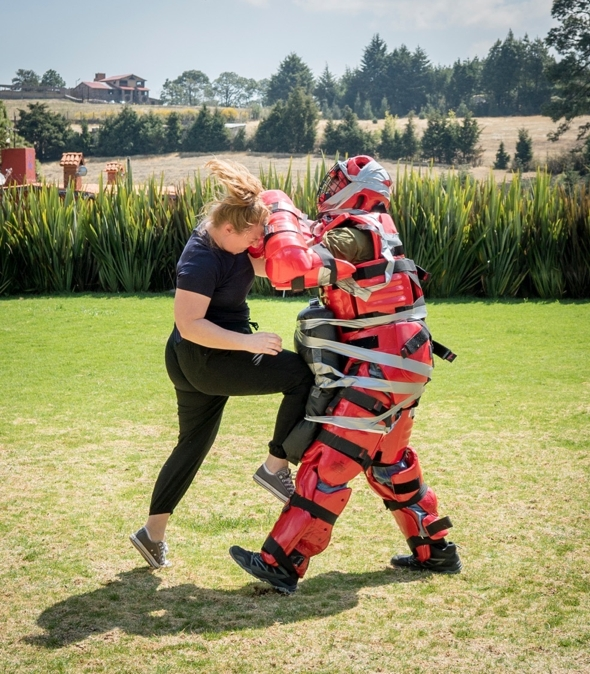Last year, Submittable interviewed Jennifer Hyman from the International Women’s Media Foundation (IWMF). An experienced journalist herself, Jennifer is the organization’s Communications Director. She spoke with us about the challenging, important work performed by the IWMF in the service of women around the world, dedicated to capturing and sharing vital stories.

To start off, can you tell me about IWMF’s mission?
We really believe that in order for the media to serve as a critical element of democracy and free expression, it must be diverse and representative. That can’t happen if women aren’t given equal opportunities to report, or if the stories people read are myopic. Through our grants, fellowships, reporting trips, and awards, we help women throughout the cycle of their careers. We also fill a void in reportage, promoting under-covered stories that might not otherwise make the media cycle. We want to ensure these stories see the light of day.
How has the organization evolved?
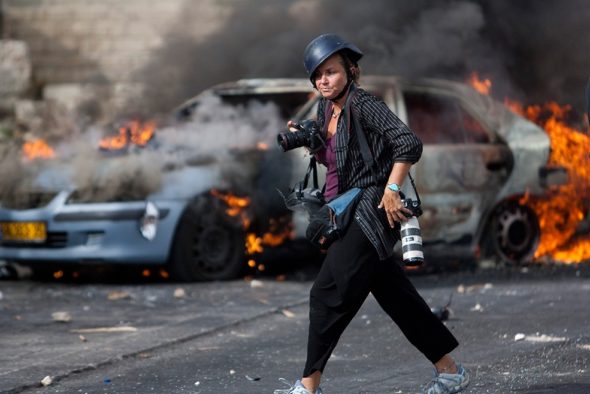
Heidi Levine, winner of the 2015 Anja Niedringhaus Courage in Photojournalism Award, at work in Jerusalem. Credit: Warrick Page.
The IWMF began in 1990 with the goal of enhancing opportunities for female journalists across the globe through scholarship and internship programs, international information exchanges, and by recognizing and honoring outstanding women in the news industry. The Courage in Journalism Awards was one of our first programs. It was designed to recognize women who courageously put themselves at risk to give us a window into critical global issues, such as conflict, harassment, and lack of press freedom. And we’re now in our 14th year of the Elizabeth Neuffer Fellowship, which provides a yearlong fellowship for one journalist focused on social justice and human rights. It was named in honor of our 1998 Courage winner Elizabeth Neuffer, who was tragically killed while reporting in Iraq in 2003.
We’ve also grown exponentially in the last several years, adding quite a number of programs. We now offer our Adelante reporting fellowship in Colombia, El Salvador, Guatemala, Honduras, Mexico, and along the Mexico-United States border. And we started the African Great Lakes Reporting Initiative in the Central African Republic, the Democratic Republic of the Congo (DRC), Rwanda, South Sudan, Tanzania, and Uganda. The goal on each of these trips is to go beyond conflict and poverty to enhance the narratives about these countries, and provide journalists with invaluable international reporting opportunities that they might not otherwise get. Most reporting trips are groups of 6-8 women journalists, and most trips have broad themes like civic engagement stories, agriculture, the environment, and humanitarian issues.
We also offer Hostile Environments & Emergency First-Aid Training (HEFAT) for all fellows in advance of their reporting trips. A training in Kenya that I participated in combined classroom training with very realistic scenarios in the field. Actors we had hired helped simulate some pretty scary situations like car crashes, kidnapping, being held hostage, riots, and the like.
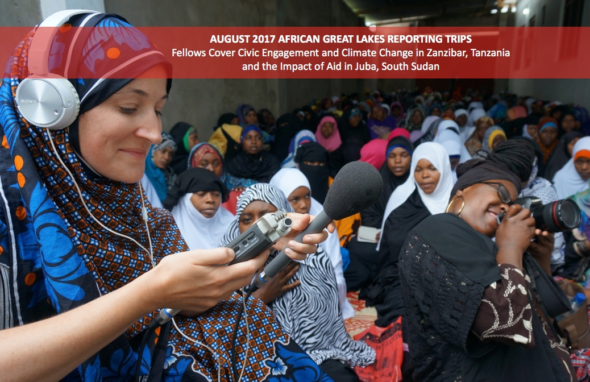
We also have two amazing grant programs, the Howard G. Buffett Fund for Women Journalists and Reporting Grants for Women’s Stories, which have also enabled grantees to produce and publish hundreds of compelling, important stories.
A few years ago, we established an Emergency Fund to support female journalists in crisis, providing them with resources for everything from flak jackets to asylum fees. It’s the only fund of its kind. And we established the Anja Niedringhaus Courage in Photojournalism Awards, which celebrates women photojournalists whose work inspires us to take action and better understand the world. We created it to honor the life of our Courage in Journalism Honoree Anja Niedringhaus, who was killed while reporting in Afghanistan.
What are the challenges for women in newsrooms?
For one, sexual harassment is pernicious. We did a research study a few years ago that showed nearly two-thirds of female journalists we asked had experienced some form of intimidation, threats, or abuse in relation to their work. We’re just starting another study to better understand the scope of online harassment in the United States. Women in any career often have the added pressures of work/life balance. In journalism, they may not be given the opportunity to get that tough assignment, to do something that is “dangerous.”
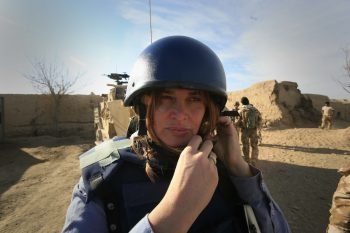
Helmand, Afghanistan, 2010 – Janine di Giovanni while embedded with British troops in Sangin Province. Giovanni won an IWMF Courage in Journalism Award in 2016. Credit: Peter Nicholls.
Women also face the challenges of largely male editorial staff and unequal pay—it’s not that different than in other industries. Journalism is historically such a male-dominated field, and even today the vast majority of writers and editors are men. We did research a few years ago that showed that 73 percent of top management positions are held by men. Women simply don’t get the opportunities they need to grow or to have flexible work schedules.
How has technology impacted your work?
Technology has had a huge impact. It’s created a totally different environment for communications. Now, we can always talk among ourselves and with our audience. By using social media to connect, we can make an even more impressive impact.
We have the opposite problem than most organizations that are struggling for content—we have new material to post pretty much every day. So we have to ask: how are we being thoughtful and strategic on Twitter and Facebook? We have so many photojournalists that our Instagram account is largely filled with takeovers led by the female photojournalists we support. We’ve had our share of challenges promoting all this content on our current website, but we are thankfully close to launching a vastly improved site soon!
Still, not nearly enough people know about our organization, even in the journalism space. One of my goals is for the general public to really know us—for someone like Meryl Streep to talk about us at an awards show.
In terms of the stories themselves, there’s a really big breadth, depth, and diversity in the outlets and countries where we’re facilitating content. While some of the women we support are staff writers at major publications like the Washington Post, New York Times, and National Geographic, it’s extremely important to us to provide opportunities to individual freelancers—who most need our support—and to support international journalists in developing countries, for whom these reporting opportunities are even harder to come by.
What advice would you offer to young female journalists getting started?
Do your best to expose yourself to different mediums and outlets. If you are freelancing, build your networks early, that way you’re not stuck with just one publication. There are many other organizations in the press freedom space—young women should really take advantage of these exciting opportunities.
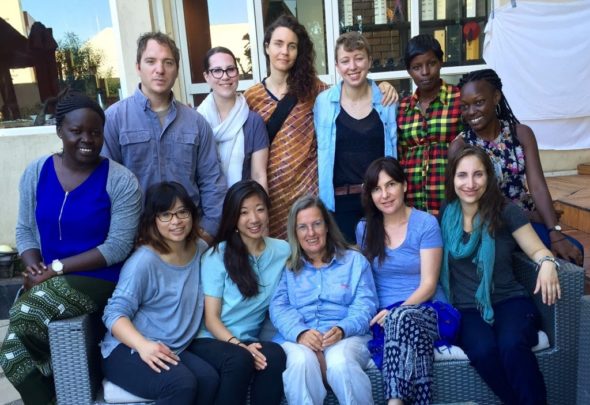
Team South Sudan, May 2016
We have a lot of first-hand anecdotes and evidence that when these women do go on IWMF trips, it can be catalytic in helping them advance in their careers. The best thing to do is to make yourself apprised and aware of opportunities, and advocate for yourself. When you are a freelancer in another country, you don’t necessarily have insurance, or protection from a repressive government. Journalists need to ensure that they are taking as many safety measures as possible and get hostile environments training.
What’s the most challenging part of your job?
Multi-tasking. We have such a wealth of information and stories that we’re facilitating. There’s also the challenge of working to ensure that we really maximize our support, and that we can, in turn, offer the best support possible. With our trips and grants, there is constantly a ton of activities going on. In between the day-to-day flow of all these important projects, we need to make sure that the journalists’ stories are really getting the attention they deserve.
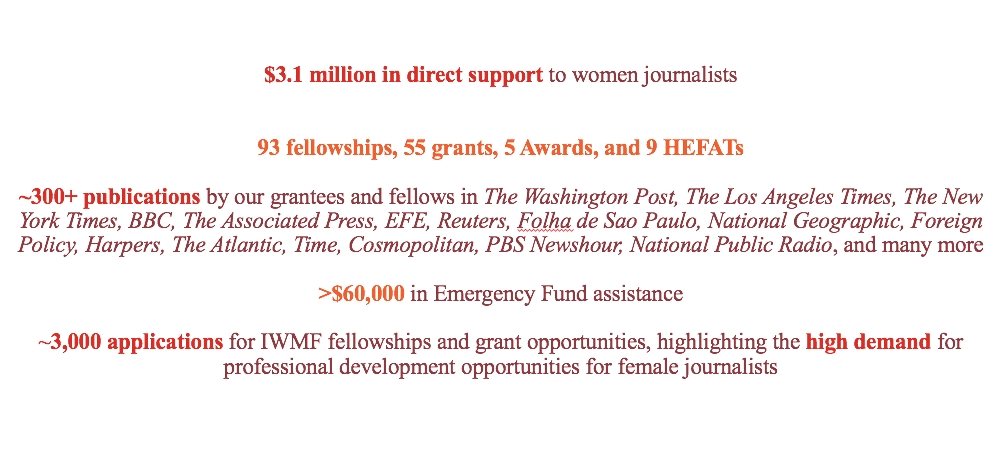
2017 figures for IWMF
We’re a small staff of 15 people, and we want to keep growing. We want to grow in a smart way to ensure that we are not diluting the quality of what we do for quantity.
How can people support women journalists?
They can demand from the publications they read that there’s diversity. When men report, the preponderance of their sources will be male. Women have different access, and can get stories and perspectives men cannot. We need all of these voices. Our ultimate vision is that we create a demand for diverse news—and diversity of all kinds. We want people to read, share, and demand the stories of women journalists.
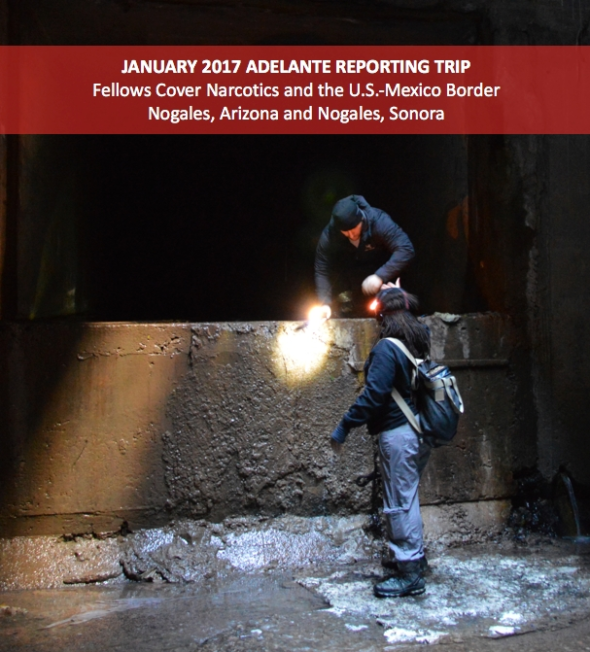
For the IWMF specifically, we want readers to follow us on social media. To share work like ours as broadly as we can. And to provide financial and volunteer support. We have so many applications—we need volunteer readers—and we need financial resources for all of our programs. Small amounts of money can really help. They can get someone a bulletproof jacket or fund psychosocial support for a journalist who has been assaulted.
Off the top of your head, who are 5 women journalists whose work we should be following/reading?
So many! Nicole Tung and Laylah Barrayn are really talented photographers who have both received funding for projects in Turkey and Senegal respectively through the IWMF’s Reporting Grants for Women’s Stories. Radio journalist Tennessee Watson, a grantee through the Howard G. Buffett Fund for Women Journalists, did an incredible project called Silent Evidence, which was run on the popular podcast, The Heart, that was founded by another grantee Kaitlin Prest, and is a finalist for the Peabody Award this year.
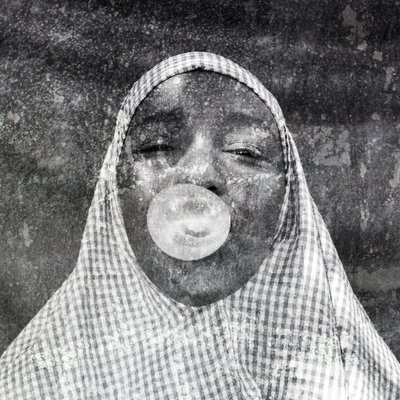
Credit: ‘Education is Forbidden’
Yoani Sanchez and her team at 14ymedio were also funded through the Howard G. Buffett Fund for Women Journalists and are doing ground-breaking work in Cuba. If you’re not familiar with the Argentinian media house and fact checking organization Chequeado, you should check them out as well, Howard G. Buffett Fund for Women Journalists grantee Laura Zommer, who founded the organization, is creating work that speaks truth to power. Nigerian photojournalist and grantee Rahima Gambo’s multimedia project “Education is Forbidden” is also stunning work. It’s so hard to pick and we’re fortunate to receive and be able to fund some incredible journalists.
Where does Submittable fit in?
We use the software for everything under the sun—fellowship applications, hiring job applicants, deciding on awards. We have applications in multiple languages. We also use it to monitor and evaluate our programs.
Female-identified journalists will find current opportunities with IWMF on their website and Submittable page. Consider supporting the work of IWMF subscribing to their mailing list, volunteering, advocating, engaging with their social media, and donating.
All images care of IWMF and IWMF 2017 Year in Review unless otherwise noted.
***



